Five reasons I shouldn’t have a pepper garden and Five reasons I do
The inception of my pepper obsession escapes me. Peppers went from Yes, jalapeños on my burger! to Yum! Let’s makes some more pepper jelly! to How many pepper varieties can I grow this year?
Growing peppers is fascinating, yet equally frustrating. My modest pepper garden has an extravagant history of false starts, flustered efforts, and full fails.
I know at least five reasons I should not have a pepper garden.
1. Shysters
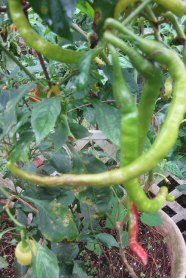
Ají Amarillo, they said. I’ll allow that “ají” in Spanish is almost as specific as saying “pepper” in English, but please. These mature to red, not yellow.
My pepper ventures begin with a bubble of excitement, selecting and purchasing pepper seeds online, imagining what those seeds will become. That bubble swells with the successful seedling, the plant, the flowers, the peppers . . . And Pop! Wait! This isn’t . . . What kind of pepper is this? I want a refund! But the line is disconnected and emails go into cyberwasteland. Shysters!
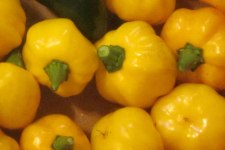
The seeds for these were sold to me as ghost. Um, no! The worst part is I fell in love with them, but I’m not sure what they are and they didn’t reseed.
2. Broken promises
Some plants keep their promises. Peppers, like the seedy seed vendors, are often renegers. My pepper seed success rate stands at about 20%, and that´s probably an exaggeration. The low performance rate is only part of the treachery. Sometimes the plant that produces a fabulously perfect pepper —Yes! That’s the seed I ordered!— exhales its last puff of oxygen days after its one and only pepper. Heroic efforts fail to perk up the limp leaves of these one-pepper wonders. I never trust a pepper plant.
3. Critters
Critters burrow, critters nibble, and sometimes critters crush the plant. As infuriating as these delinquencies can be, the most annoying critter habit of all involves my carefully placed plant labels. Why do they move my plant labels? Are they playing toss the plastic? Having pretend sword battles? My plants and my pseudo-scientific efforts to track and positively identify them often fall victim to the shenanigans of nocturnal critters. Note to self: must map the garden plot.
4. Insects
The beginning of any season is bliss. The beds are fresh, and that order-day bubble of excitement billows with hope. The seedlings will mature, the seeds will produce what the label says they should, the newspaper and mulch will control the weeds . . . But one bright morning, Pop! The stink bug convention is in full swing! Before long, my garden becomes a playground for stink bug babies, tiny other-worldly nymphs with creepy red bodies. I battle other insect invasions, but stink bugs are the most aggressive. I only use organic pesticides, so short of grabbing the leaf-footed bugs and crushing them against my thighs, there is no instant termination. I dust them with diatomaceous earth, coat them with neem oil solutions, shoo them away, and pray my dreams aren’t infested with them.
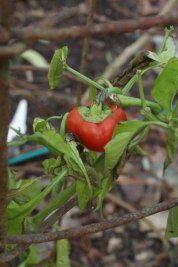
I’ve eked out a few peppers from this plant, but it has been unhappy since seedlinghood.
5. Peppers
Peppers are bratty, lazy children. No, not yet! I’m tired! I’ll germinate tomorrow. Too much water! I need more water! Additionally, the peppers that manage to survive the critters and insects are prone to almost any disease, bacteria, or fungus that gambols through the garden. My inchoate gardening skills are part of the problem, but a PhD in peppers could not sufficiently school me on the essentials and afflictions of my pepper plants.
The list of frustrations goes on. Even success can be frustrating because the yield is never just right. Too few to follow the recipe or too many to use before the peppers surrender to mush.
Why am I still pampering pepper plants? Five possible reasons:
1. Challenges

I spy candied scotch bonnet, pickled pimento pepper, pickled pizza pepper, pickled planet pepper, chocolate ghost jelly, angry ginger (scotch bonnet) jelly, and candied jalapeños.
I love a challenge. This one goes beyond negotiating my way around seed shysters, nocturnal critters, and alien insects. This challenge has culinary and intellectual branches. What can I make with this pepper? How can I showcase this pepper’s attributes without killing a friend? The more I learn about peppers —from names and types of plants to different canning and storing methods—, the more I know I don’t know. I’m sure that even my last pepper plant will teach me something, a lesson in survival, a story of surrender, an anecdote about its indigenous history, or maybe a simple moment of grace as I accept the firm, perfect pepper my plant offers.
2. Grounding
Gardening, especially cultivating peppers, takes me out of my head and into the dirt. Many gardening acts feel holy: harvesting compost and worm castings, organizing seed trays, mixing organic elements. The garden is my quiet room, where I sow and weed thoughts, pamper ideas, and whisper affirmations. I find myself in the failures and bounty of the plants, especially my pepper plants.
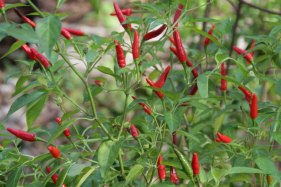
Ascent peppers are easily confused with Tabasco peppers. No one understands the name on first try. Scent peppers? No, ascent peppers. Cent peppers? No AH-scent. Sent? Writes down the name.
3. Excitement
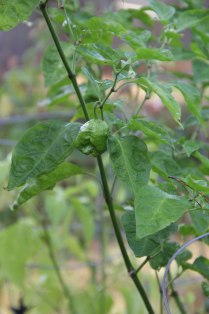
This baby moruga scorpion looks innocent enough, but it is a member of the pepper family that is being touted as the hottest in the world.
Discovery, exploration, and, of course, heat. Each year I discover new varietals we must try and explore recipes and techniques. What are we having for dinner? I still can’t answer, Peppers! But peppers are the exciting compliment, brightening a dish with bold flavors and color. Elation escalates with rising Scoville ratings. Even people who can’t tolerate hot peppers are fascinated by heat. They will watch with anticipation as a friend bites into a spicy morsel and dance with excitement when the friend´s eyes tear up from the heat. Like many pepper addicts, I’m on a quest to grow the hottest varieties available. My mission, however, is divergent. I aim to tame. I dance with excitement when I harness the hottest devils and chaperon them into palatable jellies, sauces, and relishes.
4. Beauty
Peppers are art —my garden canvas, my kitchen palette, my pepper gallery. The pepper laden limbs, a basket full of ripe peppers, jars of pickled peppers, the goat cheese log draped in bright pepper jelly. Beautiful art. Although they will never be the reliable what’s-for-dinner vegetable, peppers are a splendid extravagance, the aesthetic bounty I harvest and share with friends and colleagues.
5. Peppers
Peppers are my garden children, unpredictable attention seekers. Watch me dance! Watch me shine! Listen to my story! Did you know I can . . . ? The peppers that survive my 80%-plus failure rate are worth the frustrations and stink-bug nightmares. I shamelessly show them off to anyone who gives me a moment. I parade my pepper jellies at parties, share pepper photos, fill gift boxes with pepper delicacies. I love peppers. No apologies.
Notes and tips for my fellow pepper enthusiasts
Not all seed vendors are trustworthy. So far, these are vendors I do trust: Territorial, ChilePlants, and Peaceful Valley.
This is a list of some of the positively identified peppers that I’ve successfully cultivated. The list of failed attempts is longer.
alma paprika, ancho, ascent, banana, various bells, Bulgarian carrot, Caribbean (or maybe Bolivian?) red, cayenne, cayenne thick, chocolate ghost, fireball, habanero, ghost, jalapeño, NuMex Jo Parker, moruga scorpion, moruga scorpion yellow, pizza, planet, purple jalapeño, scotch bonnet, Serrano, sheepnose pimento, sweet chinese giant, Tabasco, Trinidad scorpion
If you harvest seeds for the next season, clean, dry, and store them in sealed bags or containers in the freezer.
Pre-soaking seeds in solutions of saltpetre or citric acid can help overcome stubborn germination.
Start the seeds in seed trays or hydroponic systems.
Start early! I start making seed trays in late January and early February, but many of my pepper plants don´t start performing until late summer or fall. They can be painfully sluggish.
If you live in a warm climate, many of your peppers can winter over. Pamper them through the cold months, and protect them from the occasional freeze.
Copyright © 2015 by Pennie Nichols, All Rights Reserved.


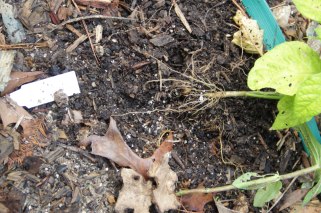
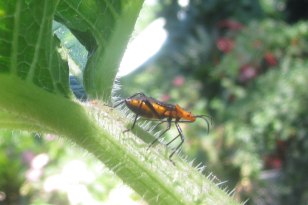


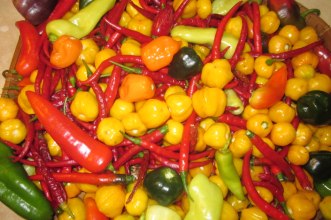

You’re a serious gardener. I love your “why”. I have tried and failed with Red peppers that only get green. But to be honest, I do have a black thumb.
You’re the first person I know who’s grown peppers. I love houseplants, but no matter what I do, the deer and the other critters find a way to eat–or destroy–what I grow outside. Brenda